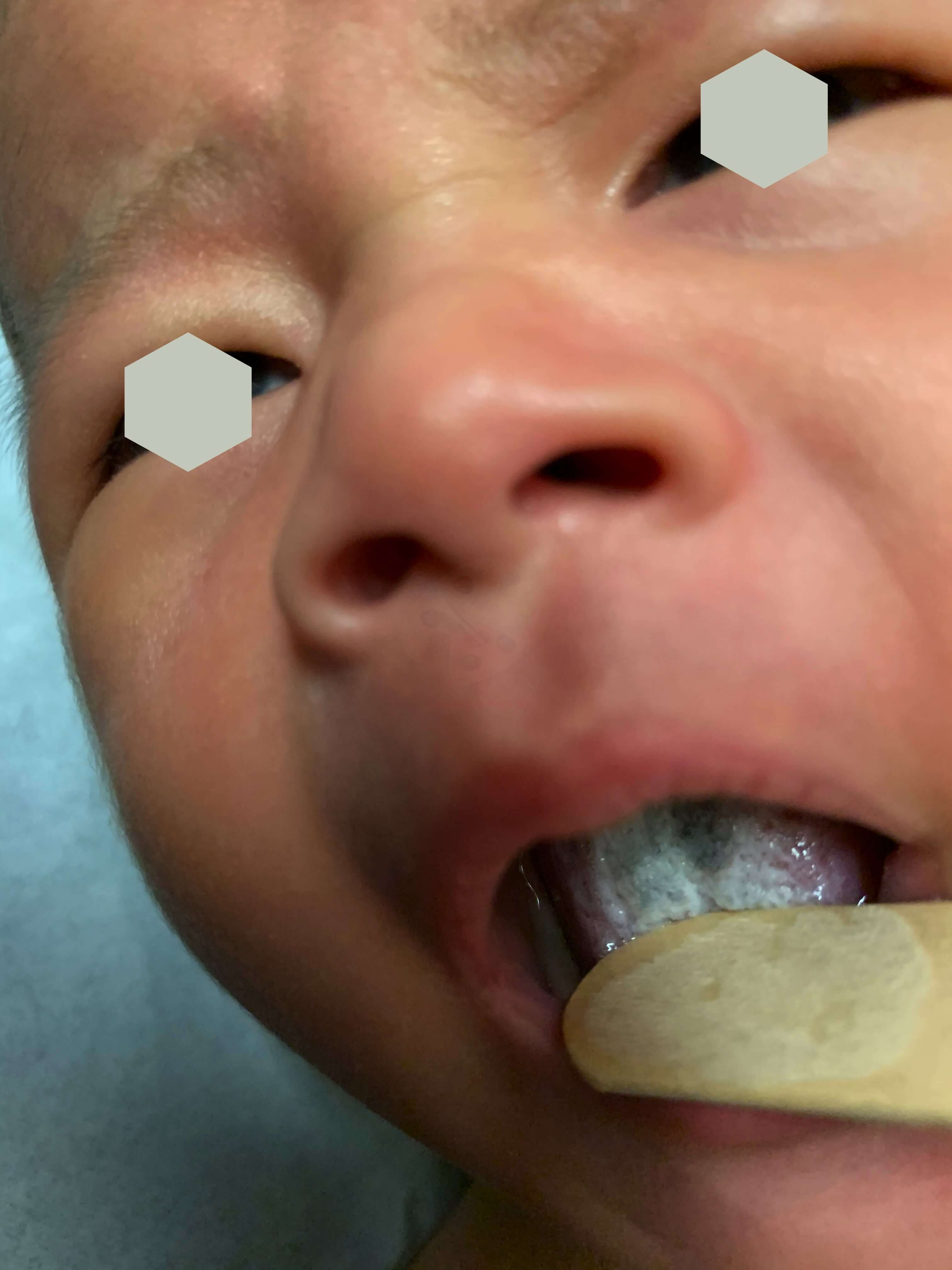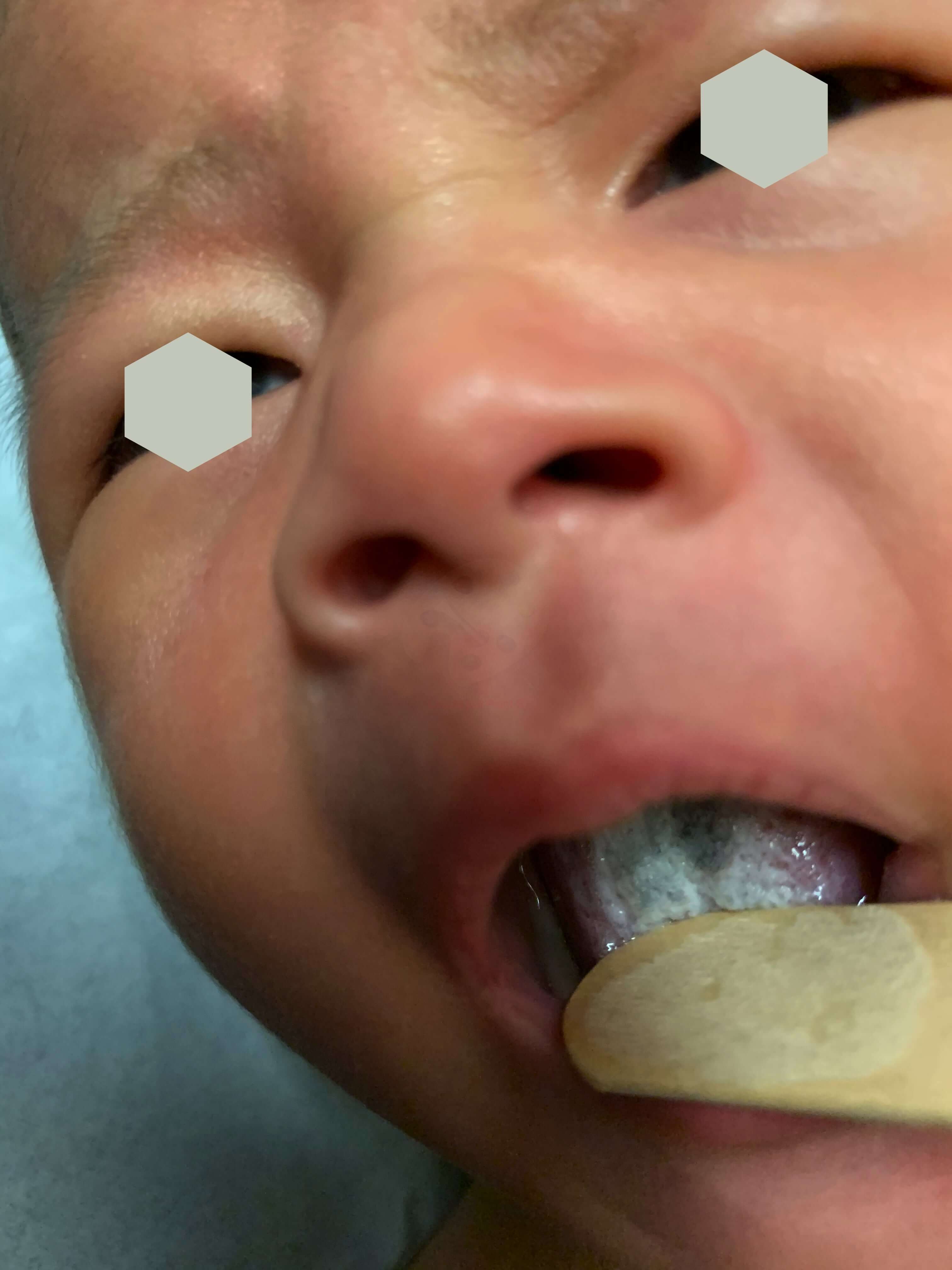|
Língua villosa nigra in an infant
Mariana Eiras Dias, Luísa Queiró, Rita Barreira.
Pediatric Department, São Francisco Xavier Hospital, CHLO, Lisboa, Portugal.
ADDRESS FOR CORRESPONDENCE
Dr. Mariana Eiras, Rua das Lameiras n1, Freiria, 2565-281, Portugal.
Email: diasm14@hotmail.com
Lingua villosa nigra, Pediatrics, Black tongue, Tongue, Hairy, Oral Hygiene
A 5-week-old male infant, with no significant family history and a term pregnancy (birth weight of 3510 grams (P50)) adequately monitored, was taken to the emergency department (ED) due to a change in the color of the tongue first noticed a week earlier. The patient was exclusively breastfed and was supplemented with adequate dose of vitamin D beginning in the first month of life. Physical examination revealed a blackish discoloration of the posterior 2/3 of the tongue´s dorsal area (Figure 1), that did not disappear with the rubbing of the spatula. No other abnormality in the oral cavity was present including any signs of trauma. He was treated with miconazole gel for the previous week without any changes in the condition. He had a normal length and weight evolution (percentile 50) with no feeding difficulties. Vaccines were according to the national immunization schedule. There were no other accompanying symptoms namely respiratory, nor vomiting, diarrhea, constipation, and no history of herbal products ingestion.
Figure 1. Lingua villosa nigra.

|
Figure 1. Lingua villosa nigra

|
What is the Diagnosis?
Tongue cleaning with a soft brush was recommended and a complete resolution was seen in about 2 weeks, prompting the diagnosis of lingua villosa nigra. Lingua villosa nigra is a benign and self-limited entity, extremely rare in pediatric patients, particularly in young infants.1 Nine cases are described in the anglo-saxon literature, the youngest patient being 1 month old.2,3 Although its precise pathogenesis is still uncertain, it is thought to be linked to alterations of desquamation and reactive hypertrophy of the filiform papillae altering the normal cleaning process of the tongue leading to a bacterial overgrowth.1,4 Usually, this condition doesn´t involve the tip nor the side of the tongue and some patients may even refer a burning of the tongue.4 The tongue´s color may vary between black, brown, green, yellow or even white[3]. Triggering factors include alcohol intake, smoking, dehydration, antibiotics, hyposalivation and tea consumption. In pediatric patients a triggering factor is rarely found.4 Incidence increases with age and it is attributed to a cumulative increase in consumption of coffee, tea and smoking.
Main differential diagnosis includes oral candidiasis and villous leukoplakia both usually associated with human immunodeficiency virus infection. Another diagnosis to keep in mind is pigmented fungiform papillae of the tongue, a normal oral pigmentation variant usually affecting dark-skinned people.4 This diagnosis is thus essential to bear in mind in order to avoid unnecessary therapeutic interventions. |
| |
| Compliance with ethical standards |
|
Funding: None
|
|
|
Conflict of Interest: None
|
|
- Körber, A, Voshege N. Black hairy tongue in na infant. CMAJ. 2012;184(1). [CrossRef] [PubMed] [PMC free article]
- Popik E, Barroso F, Pombeiro J, Carvalho C, ALmeida A. Arch Dis Child 2018;0:1.
- Schlager E, St Claire C, Ashack K, Khachemoune A. Black Hairy Tongue: Predisposing Factors, Diagnosis, and Treatment. Am J Clin Dermatol. 2017; 18(4): 563-9. [CrossRef] [PubMed]
- Emmet E, McGrath MB, Philip Bardsley MD, Gurnan Basran MD. Black hairy tongue: What is your call?. CMAJ. 2008; 178(9): 1137-38. [CrossRef] [PubMed] [PMC free article]
|
|
DOI: https://doi.org/10.7199/ped.oncall.2025.15 |
| |
Cite this article as:
Dias M E, Queiró L, Barreira R. Língua villosa nigra in an infant. Pediatr Oncall J. 2025;22: 108. doi: 10.7199/ped.oncall.2025.15
|